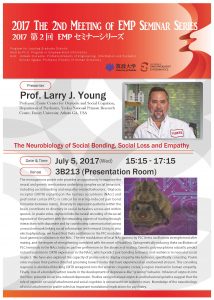2017年7月5日(水)15:15 – 17:15 : プレゼンルーム(3B213) : 2017 The 2nd meeting of EMP Seminar Series Emory University Larry J. Young教授講演会のご案内
2017 The 2nd meeting of EMP Seminar Seriesでは、Emory UniversityよりLarry J. Young教授をお招きしご講演いただきます。貴重な機会となりますので、皆様奮ってご参加ください。

日時:2017年7月5日(水)15:15-17:15
会場:筑波大学 第3エリア プレゼンルーム(3B213)
講師:Prof. Larry J. Young (Professor, Emory University)
講演タイトル:The Neurobiology of Social Bonding, Social Loss and Empathy
概要:The monogamous prairie vole provides an opportunity to examine the neural and genetic mechanisms underlying complex social behaviors, including social bonding and empathy-related behaviors. Oxytocin receptor (OXTR) signaling in the nucleus accumbens (NAcc) and prefrontal cortex (PFC) is critical for mating-induced pair bond formation between mates. Diversity in expression patterns within the brain contribute to diversity in social behaviors across and within species. In prairie voles, oxytocin links the neural encoding of the social signature of the partner with the rewarding aspects of mating through interactions with dopamine and by coordinating communication across a neural network linking social information with reward. Using in vivo electrophysiology, we found that theta oscillations in the PFC modulate local gamma oscillations in the NAc. The net modulation of local NAc gamma by PLC theta oscillations strengthened after mating, and the degree of strengthening correlated with the onset of huddling. Optogenetically inducing theta oscillations of PLC terminals in the NAcc induces partner preferences in the absence of mating. Genetic polymorphisms robustly predict natural variation in OXTR expression in the NAcc, which predict pair bonding behavior and resilience to neonatal social neglect. We have also explored the capacity of prairie vole to display empathy-like behavior, specifically consoling. Prairie voles increase their partner-directed grooming toward mates that have experienced an unobserved stressor. This consoling response is abolished blocking OXTR antagonist into the anterior cingulate cortex, a region involved in human empathy. Finally, loss of a bonded partner results in the development of depressive-like “grieving” behavior. Infusion of oxytocin into the NAcc prevents social loss-induced depression. Studies using intranasal oxytocin and behavioral genetics suggest that the role of oxytocin on social attachment and social cognition is conserved from rodent to man. Knowledge of the neurobiology of social attachment in prairie voles has important translational implications for psychiatry.


